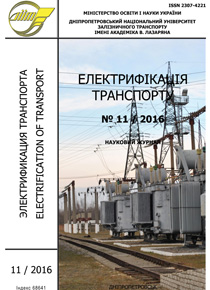The mathematical model for calculating the formation of single-group plan with through trains using set theory
DOI:
https://doi.org/10.15802/etr.v0i11.83780Keywords:
organization of traffic volumes, the theory of multiple functionsAbstract
The aim of this work is to develop mathematical models and computational methods of the organization of traffic volumes in the freight trains on the basis of vector option in order to reduce car-hours of accumulation trains at service stations.
The main objective of the study is the organization and distribution of traffic volumes in the single-group through the train at stations with a minimum of technical costs of times for their accumulation. The object of research is the network of railway technical stations races-even the landfill. The subject of research is the organization of traffic volumes in the single-group through the train. The method of research is the theory of multiple functions. Scientific novelty lies in solving the problem of linear programming in boo-left variables using multiple functions leading to the search for a plurality of minimizing the objective function under certain restrictions on the elements of the set.
The necessary conditions for solving the problem of vector optimization in the calculation of the plan of forming single-group cross-train on the range selected network stations.
References
Duvalyan, S. Razrabotka algoritmov i programm rascheta setevogo plana formirovaniya poezdov [Development of algorithms and calculation power train formation plan programs]. Moscow: "The report on the research work" VNGITS Publ., 1978. 120 p.
Papahov A. Vnutridorozhnyy plan formirovaniya poezdov. Cand. Diss. [Inside ground plan for the formation of trains. Cand. Diss.]. Moscow, 1990. 140 p.
Osminin, A. Ratsional'naya organizatsiya vagonopotokov na osnove metodov mnogokriterial'noy optimizatsii. Dokt. Diss. [The rational organization of traffic volumes on the basis of multi-criteria optimization methods. Dokt. Diss.]. Samara, 2000. 261 p.
Papahov A. Elementy vdoskonalennya metodyky rozrakhunkiv planu formuvannya poyizdiv [Elements of improvement of methodology of calculation of the plan of formation of trains] Visnyk Dnipropetrovs'koho natsional'noho universytetu zaliznychnoho transportu im. akademika V. Lazaryana [Bulletin of Dnipropetrovsk National University of Railway Transport named after Academician V. Lazaryan],2006, no.12,- pp 91 - 93.
Bosov A. Funktsii mnozhestva i ikh primenenie [Set Functions and Their Applications]. Dnieper-Dzerzhinsk, "Andrei" Publ., 2007. 182 p.
Kiseleva E. Nepreryvnye zadachi optimal'nogo razbieniya mnozhestv. Teoriya, algoritm, prilozheniya [The continuous problems of optimal partitioning sets. Theory, Algorithms, Applications]. Kyiv, Naukova Dumka Publ., 2005. 564 p.
Ilyin, V. Analiticheskaya geometriya [Analytic Geometry]. Moscow, 2002. 240 p.
Prokhorov, G. Paket simvol'nykh vychisleniy Maple [Package Maple symbolic computation]. Moscow, "Pezhit" Publ., 1997. 200 p.
Downloads
Published
Issue
Section
License
При направленні статті в редакцію, автор гарантує, що стаття надається для публікації уперше і раніше не була опублікована в інших виданнях повністю або частково.
Підписанням ліцензійного договору автор(и) підтверджує(ють), що має(ють) виняткове авторське право на статтю і передає(ють) невиняткові права на свою статтю видавництву журналу «Електрифікація транспорту» для публікації в черговому номері журналу. Автор(и) так само дає(ють) згоду на передачу і розміщення електронної версії своєї статті на сайтах баз даних, створюваних і поширюваних через Інтернет.
